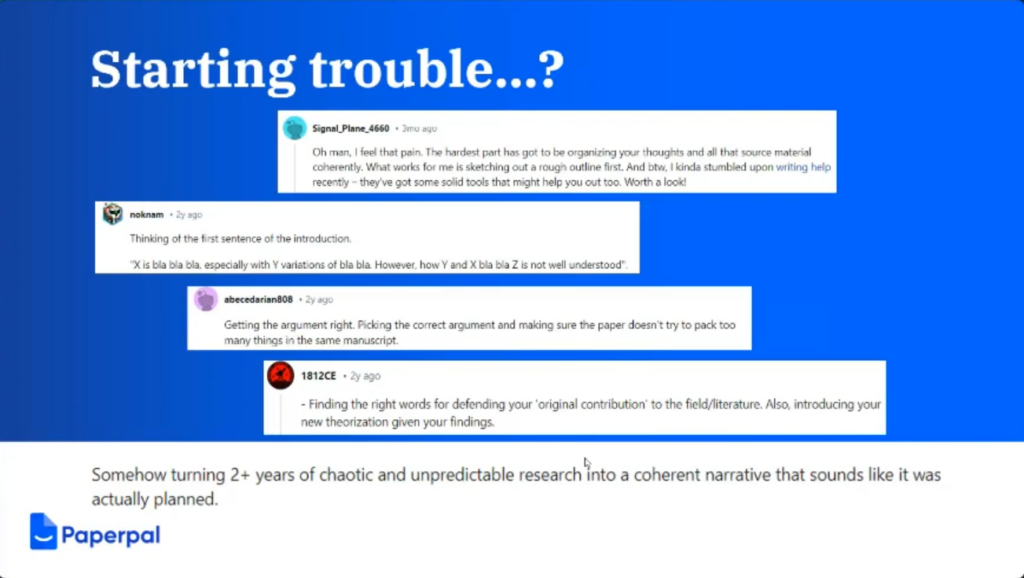Do you encounter writer’s block during the first draft of a research paper? Crafting a clear outline from your initial ideas and notes can feel like a daunting first hurdle. Many researchers and students struggle with the initial stages of research paper writing. Uncertainties about content structure, information selection, and weaving complex findings into a cohesive narrative can lead to staring at a blank page.
Table of Contents
- How do Paperpal’s AI-generated outlines help you write the first draft 2x faster?
- How to write the first draft of a research paper with Paperpal?
A glimpse into academic forums and social media gives a clear picture that many researchers across the world go through similar problems while writing the first draft of a research paper. Where to begin? What should I write? How to begin? How to compile 2-3+ years of research into a 2500 or 5000-word research paper? If you’re grappling with these concerns, do not worry. You’re not alone.

Researchers face a mountain of work when it comes to writing papers. Paperpal decided to tackle this challenge and, in the process, discovered some fascinating writing habits:
- Start verbally: Some researchers find their flow by talking through their ideas first. They record themselves or brainstorm with a friend, then use these spoken notes as a springboard for their draft.
- Write on the go: Others prioritize keeping their thoughts flowing freely. They write in bursts, leaving the structuring and editing for later.
- Divide and Conquer: For some, especially new researchers, a structured approach works best. They break the paper into sections, focusing on building each one in detail before assembling the final draft.
- Outlines: Many researchers swear by outlines. Outlines provide a roadmap, complete with headings, subheadings, and key points. This saves time in the long run by eliminating the need for major restructuring later. You can focus on polishing the language and adding academic vocabulary during the final edit.
Inspired by the outline method, Paperpal set out to create a tool that would give researchers a head start. This led to the development of Paperpal’s AI-generated outlines, which build a rough skeleton for your draft, allowing you to flesh out each section with confidence.
How do Paperpal’s AI-generated outlines help you write the first draft 2x faster?
Unlike traditional outlining methods, Paperpal doesn’t just provide a generic structure. Paperpal’s AI-generated outlines identify the key topics that form the backbone of your draft, providing a clear structure without sacrificing crucial elements.
AI-generated outlines with a personalized approach
Paperpal goes beyond just suggesting topics. It seamlessly integrates your input, including notes, ideas, and research findings. This ensures the generated outline reflects your unique perspective and aligns perfectly with your project goals. This personalized approach not only streamlines the drafting process but also fosters a sense of ownership, keeping you engaged and motivated.
Identify gaps to strengthen your research paper
After creating an outline based on your notes, Paperpal takes things a step further by helping you flesh out each section with content suggestions. Let’s say you’re working on the introduction of your research paper. Paperpal not only analyzes your notes to generate an outline, but it also identifies potential gaps in your research. It can then suggest content additions like knowledge gaps, research questions, and rationale statements to address those weaknesses. This comprehensive support streamlines the writing process for your first draft, making it smoother and more effortless.
Researchers who have incorporated Paperpal into their workflow, have achieved higher levels of academic writing productivity. The result? Producing the first draft of a research paper in a shorter time frame, without making it completely AI-driven.
How to write the first draft of a research paper with Paperpal?
Paperpal redefines the way researchers approach academic writing, transforming the once-daunting task of drafting into a breeze. Here’s a walkthrough of writing the first draft of a research paper with Paperpal.
Step 1: Creating a research paper outline
- Sign- up to Paperpal and open a new or existing document.
- Navigate to Templates, select Outlines and choose Research Article to begin.
- Fill out the necessary details in the required fields according to your needs. Add your research notes to the Brief Description section and click on Generate.
Paperpal gets you started on the right foot by analyzing your information and generating a comprehensive outline. This roadmap for your draft breaks down the content into clear, logical sections:
- Background: Sets the context for your research.
- Topic Importance: Highlights the significance of your research area.
- Existing Knowledge: Summarizes what’s already known about the topic.
- Knowledge Gap: Identifies areas where further research is needed.
- Rationale: Explains why your research is important to address the gap.
- Research Question: Formulates the specific question your research aims to answer.
- Aim/Objective: Defines the overall goals and desired outcomes of your research.
- Hypothesis: Makes a prediction about the expected results of your study (optional, not all research papers require a hypothesis).
Paperpal’s outline provides a head-start to structure and write your research paper. This process helps in laying a strong foundation for your writing and refining it effortlessly.
Step 2: Breaking down the outline into sections
Once you have the initial outline, you can further refine it by dividing it into subsections. This helps you explore each aspect of your research in detail, ensuring thorough coverage of your topic. You can choose from pre-built sections like Introduction, Methods, Results, Discussion, and Conclusion and start developing one by one.
Step 3: Drafting the research paper
Start your research paper’s draft based on the outline and custom section enhancements. During the writing phase, Paperpal also offers insights into using its features:
- Incorporating references and additional content as required
- Rephrasing, shortening sentences, and refining language and structure using Paperpal’s Edit and Rewrite options
- Refining your draft by adding citations and specific information relevant to the topic via Paperpal Research. This ensures originality, and clarity, and adds value to your writing.
By streamlining the journey from raw research to a polished draft, Paperpal helps students, researchers, and academics overcome common writing hurdles and achieve greater productivity. Whether you are a seasoned researcher or a student, Paperpal serves as a trusted companion, guiding you through each stage of the drafting process. Unlock academic writing potential with Paperpal. Get your free Paperpal account today!
Paperpal is a comprehensive AI writing toolkit that helps students and researchers achieve 2x the writing in half the time. It leverages 21+ years of STM experience and insights from millions of research articles to provide in-depth academic writing, language editing, and submission readiness support to help you write better, faster.
Get accurate academic translations, rewriting support, grammar checks, vocabulary suggestions, and generative AI assistance that delivers human precision at machine speed. Try for free or upgrade to Paperpal Prime starting at US$19 a month to access premium features, including consistency, plagiarism, and 30+ submission readiness checks to help you succeed.
Experience the future of academic writing – Sign up to Paperpal and start writing for free!



